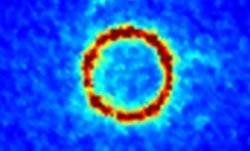Jun 18 2010
Physicists at the University of Sydney have brought silicon chips closer to performing all-optical computing and information processing that could overcome the speed limitations intrinsic to electronics, with the first report published of an on-chip all-optical temporal integrator in Nature Communications today.
 The optical integrator is about ten times
faster than the best electronic integrator. Image: University of Sydney
The optical integrator is about ten times
faster than the best electronic integrator. Image: University of Sydney
An all-optical integrator, or lightwave capacitor, is a fundamental building block equivalent to those used in multi-functional electronic circuits.
Associate Professor David Moss, a senior researcher within the Institute for Photonic and Optical Science (IPOS), leads an international team which has developed the optical integrator on a CMOS compatible silicon chip.
The device, a photonic chip compatible with electronic technology (CMOS), will be a key enabler of next generation fully-integrated ultrafast optical data processing technologies for many applications including ultra-fast optical information-processing, optical memory, measurement, computing systems, and real-time differential equation computing units.
It is based on a passive micro-ring resonator and performs the time integral of an arbitrary optical waveform with a time resolution of a few picoseconds, corresponding to a processing speed of around 200 GHz, and with a "hold" time approaching a nanosecond.
This represents an unprecedented processing time-bandwidth product (TBP) - a principal figure of merit, defined as the ratio between the integration time window to the fastest time feature that can be accurately processed - approaching 100 - much higher than advanced passive electronic integrators where the TBP is less than 10.
The research has just been published in a paper entitled On-chip CMOS compatible all-optical integrator in the international journal, Nature Communications.
Associate Professor Moss said using light for ultrahigh speed information processing, computing, and storage on a silicon chip was an important breakthrough.
"With society's demands for even faster technology, ultrafast optical computing and signal processing are important," he said.
"This on-chip optical integrator is a key to enabling many optical functions on a chip, including ultra high speed signal processing, computing, and optical memory.
"This technology will ultimately provide the consumer with cheaper and faster computers."
The device, based on high index doped silica glass, is low loss and has a high degree of manufacturability and design flexibility. This makes it an ideal ultrahigh speed optical integrator with a performance good enough not just for optical computing but for a wide range of applications including optical memory, real-time differential equation computing units, and many others.
Associate Professor Moss is a researcher with the Centre for Ultrahigh Bandwidth Devices for Optical Systems (CUDOS), an ARC Centre of Excellence.